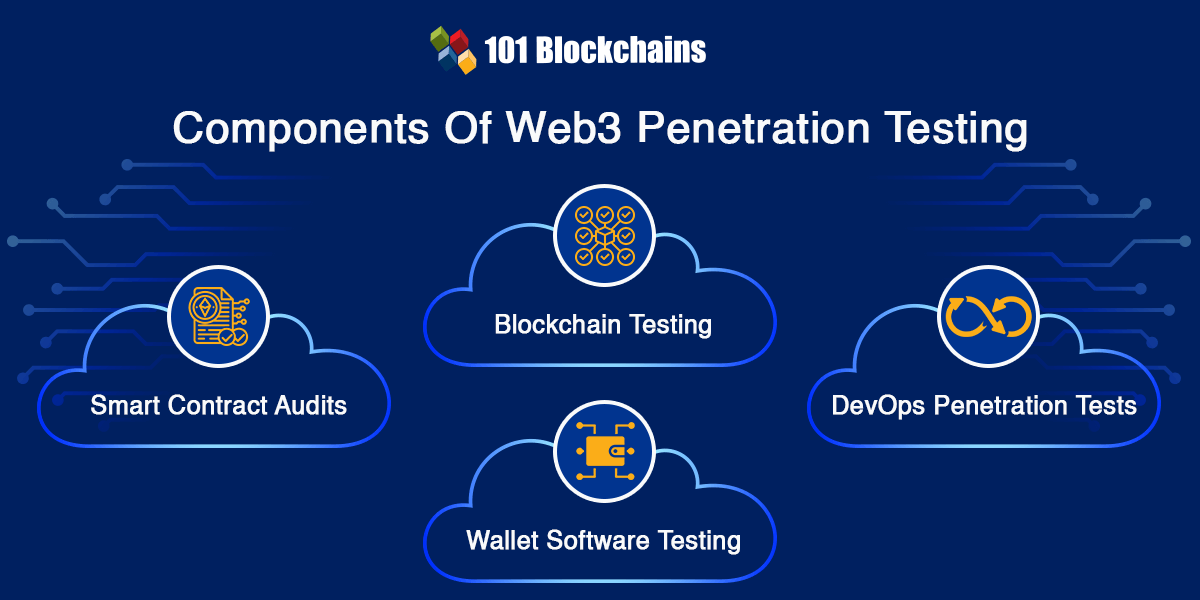A Detailed Guide To Web3 Penetration Testing

Web3 represents a new version of the internet that would leverage blockchain technology, smart contracts, and dApps for decentralization. It aims to create a more secure, democratic, and transparent variant of the web. As compared to traditional web applications, web3 apps depend on a distributed network of nodes for validation of transactions alongside implementing additional functions.
However, security has emerged as a major concern for web3, primarily due to the use of smart contracts. Even a comprehensive web3 security audit could miss notable vulnerabilities such as integer overflow attacks, denial-of-service attacks, and reentrancy attacks. Furthermore, the decentralization in web3 apps also presents a formidable security concern as the apps would not have a centralized server or authority for taking care of security. In addition, web3 is largely open-source in nature, thereby enabling hackers to access the code and unravel vulnerabilities.
You might be wondering about the solution to the web3 security issues as they could impose a massive burden of financial losses. Interestingly, you can find a reliable answer for avoiding web3 security issues in penetration testing. Penetration testing for web3 apps can help in evaluating dApps smart contracts alongside other web3 components for identifying vulnerabilities and potential sites of attack.
You must understand the importance of web3 penetration testing, its different variants, and the methodology for penetration testing in web3 applications. Let us learn more about penetration testing in web3 and how it works.

What is Web3 Penetration Testing?
Penetration testing or pentest in web3 is similar to the approaches followed for security testing in web2 applications. Anyone who wants to learn Web3 should know that web3 development has gained significant improvement in momentum. Many companies and developers want to capitalize on the web3 technologies and principles for embracing the decentralized web. Web 3.0 is a revolutionary paradigm that changes the functioning of different industries, such as finance, gaming, and supply chain management.
The number of web3 startups has been growing steadily alongside the continuously expanding volumes of investment in web3. However, the growing popularity of web3 also paves the path for web3 vulnerabilities that can lead to irreversible consequences. If you go through the recent reports about web3 security, you can find that web3 security issues cause massive losses.
For example, the total financial losses due to web3 security breaches in 2022 were over $3.5 billion. In addition, reports have pointed out that the losses due to web3 security breaches in the first six months of 2023 have crossed $650 million. Therefore, it is important to look for proactive methods that can help safeguard user data, funds, and integrity of blockchain architecture.
Penetration testing can outperform the most powerful web3 security tools for safeguarding web3 apps and users. Penetration testing in web3 is a comprehensive process for evaluating the security of smart contracts, blockchain networks, and dApps. The recommended approach for penetration testing in web3 focuses on simulation of real-world attacks for identifying weaknesses and vulnerabilities in the web3 landscape.
Learn the fundamentals, challenges, and use cases of Web3.0 blockchain from Introduction To Web 3.0 E-Book
Difference between Traditional Penetration Testing and Web3 Penetration Tests
Web3 penetration tests differ from traditional penetration testing in different ways. The first difference is evident in the fact that web3 apps run in decentralized environments, which presents specific security risks. For example, smart contract vulnerabilities could open new surfaces of attack for hackers. In addition, web3 apps also follow different protocols and interfaces, such as JSON-RPC, which requires specialist testing knowledge and equipment.
Another differentiating factor between web3 and web2 penetration tests is the use of blockchain technology. When you learn web3, you can find out that web3 apps feature inherent security traits. However, the inherent security traits could not safeguard web3 apps against vulnerabilities in the code or approaches for interacting with blockchain.
Most important of all, you must also focus on the necessity of specific regulatory requirements for web3 during penetration testing. For example, DeFi applications must comply with financial regulations in their search for vulnerabilities.
Excited to learn about the critical vulnerabilities and security risks in smart contract development, Enroll now in the Smart Contracts Security Course
Working of Penetration Testing in Web3
You must know about the ideal steps for implementation of penetration testing in web3 to ensure the best results. Effective penetration testing in web3 requires comprehensive planning and developing the scope of the testing project. Effective planning for a web3 security audit could help in identification and evaluation of all the potential vulnerabilities in web3.
Some of the critical stages in the planning stage include establishing the objectives and milestones for the project. Subsequently, you would move towards other stages of penetration testing, such as understanding the architecture and development of testing strategy. Here is a detailed overview of different steps in the working of web3 penetration tests.
-
Define the Aim of Testing
The first stage of web3 penetration testing involves clear definition of objectives and scope of testing. What are the objectives for web3 penetration tests? You have to choose the precise targets, such as dApps, smart contracts, or wallets. It is important to understand the target environment to ensure the identification and assessment of all potential vulnerabilities.
-
Understanding the Architecture and Technologies
One of the significant requirements for successful penetration testing in web3 points to your understanding of web3 architecture and technologies. Web3 apps utilize different tools and structures in comparison to traditional web applications. Therefore, you must learn web3 architecture and technology with a clear impression of web3 protocols and interfaces, blockchain technology, and smart contract programming languages.
Curious to develop an in-depth understanding of web3 application architecture? Enroll now in the Web3 Application Development Course!
-
Select the Testing Procedure
The next stage in the working of penetration tests involves specification of testing procedures required for the tests. You can choose automatic or manual web3 tests. On top of it, you could find dedicated web3 security tools and frameworks for web3 penetration tests. With a clear impression of testing objectives and the target environment, you can pick the ideal tools for successful penetration tests.
-
Prepare Your Testing Plan
The final stage in the planning phase of the working of penetration tests in web3 involves preparation of testing plan. Once you have defined the objectives, testing techniques, and target environment, you have to create a testing plan. The testing plan would include details about the tests that you would implement and the required tools for the same.
In addition, you could also determine the timing of different tests. It is important to review the testing plan and strategy with the involvement of all parties to obtain authorization from all the stakeholders.

Types of Penetration Tests in Web3
The next topic of discussion in a guide to penetration tests in web3 focuses on variants of penetration tests. You should note that penetration tests involve simulation of attacks on web3 systems and networks for identifying vulnerabilities. At the same time, you might come across three distinct types of web penetration testing for mitigating web3 security risks. Here is an outline of the different types of penetration tests involved in web3.
-
External Network Penetration Tests
External network penetration tests focus on identification of vulnerabilities in the perimeter safeguards for web3 apps. In such types of penetration tests, you can find simulations of attacks from external threat actors. The tests help in determining the effectiveness of security controls, such as web application firewalls, firewalls, and intrusion detection systems. The external network penetration test can help in identifying crucial vulnerabilities such as weak password policies, open ports, and unpatched software.
-
Internal Network Penetration Tests
The next variant of penetration test for identifying web3 vulnerabilities is the internal network penetration test. Internal network penetration tests work through simulation of scenarios where a malicious actor gains access to internal network of web3 apps. Such types of penetration tests focus on identifying internal vulnerabilities such as misconfigured access controls, inappropriate network segmentation, and unsecured databases.
-
Application Penetration Test
Web3 security professionals must also focus on the application penetration tests to determine vulnerabilities in the application itself. Application penetration tests are a mandatory addition to web3 security audit as they help in recognizing security issues such as authentication bypass, SQL injection, or cross-site scripting. Application penetration testing is a powerful tool for safeguarding privacy of user data alongside preventing unauthorized access.
Want to identify the benefits, challenges, and risks of web3? Enroll now in the Certified Web 3.0 Professional (CW3P)™ Certification
What are the Other Components of Web3 Penetration Tests?
Penetration tests in web3 do not focus on simulation of attacks on the perimeter of web3 apps, their internal networks, and the application itself alone. You could find other components in penetration tests that help in uncovering a wide range of vulnerabilities in web3.
The components in web3 penetration tests include smart contract audits, blockchain testing, wallet software testing, and DevOps penetration testing. Each component plays a crucial role in web3 penetration testing by reviewing different aspects of web3 for security issues. Let us take a look at the important areas of testing in each component of web3 penetration tests.

The role of smart contracts in the web3 ecosystem cannot be undermined. Smart contract audits form a crucial part of web3 security audit procedure as they help in testing access control, transaction order dependency, vulnerability to denial of service, and other asset management capabilities. The common vulnerabilities identified in smart contract audits include time manipulation, insufficient access controls, reentrancy attacks, and short address attacks.
Want to understand the importance of smart contracts audits? Check out Smart Contract Audit Presentation now!
The types of tests involved in penetration testing also involve blockchain testing, which checks vital components and potential attack surfaces. Blockchain testing involves evaluation of peer-to-peer protocol vulnerabilities, blockchain block parsing, RPC authentication, and secure RPC method implementation. The common attack surfaces identified in blockchain testing include communication interfaces, OS and services, DevOps, and input management.
-
Wallet Software Testing
The review of web3 security tools and their importance also reflects on the necessity of wallet software testing. Some of the important components involved in wallet software testing include a user interface, RPC interface, software dependencies, and transaction management. In addition, wallet software testing in web3 penetration tests also reviews the connection of web3 wallets to the third-party nodes and services.
-
DevOps Penetration Tests
Another notable addition among the types of web penetration testing for web3 points at DevOps penetration testing. DevOps has become an open target for malicious actors owing to its large technological footprint and limited security controls. In addition, DevOps also offers privilege for modification of source code and deploying it into production.
The primary focus of DevOps penetration tests is directed toward assessment of code repository contents and access privileges, secrets management, and access to production deployment. DevOps penetration tests also focus on the CI/CD infrastructure alongside authentication for sensitive development components and developer access to the production credentials.
Want to explore an in-depth understanding of security threats in DeFi projects? Enroll In DeFi Security Fundamentals Course now!
What are the Popular Tools for Web3 Penetration Tests?
The specific design of web3 apps requires the use of specialized tools for penetration testing in web3. You can rely on web3 security tools to support web3 developers and security professionals in recognizing and addressing vulnerabilities. Here are some of the most popular.
Mythril is a smart contract security analysis tool for smart contracts deployed on Ethereum. It also offers the flexibility for identifying different web3 vulnerabilities, including logical errors, reentrancy, and integer overflow or underflow.
EthFiddle is one of the emerging tools in the web3 security landscape, as it can help programmers create and test Ethereum smart contracts in a browser-based environment. The security testing tool features different simulation tools alongside an integrated debugger for evaluation of smart contract security posture.
Another notable addition among tools for web3 security points at ZAP. It works as a web3 app security scanner and features different plugins for testing web3 apps.
Start your journey to becoming an expert in Web3 security skills with the guidance of industry experts through Web3 Security Expert Career Path
Final Words
The overview of web3 penetration testing showcases that it is an ideal technique for security of web3 apps. Web3 security has emerged as a formidable concern for developers and the broader web3 community due to humongous financial losses. On top of it, the decentralization and open-source nature of web3 expose web3 apps to different types of security risks. Users can find the ideal countermeasures for avoiding such security risks by using penetration testing.
It is important to understand that web3 penetration tests could deviate from conventional penetration testing in certain aspects. However, the ultimate objective of penetration tests revolves around a simulation of attacks to check the resiliency of web applications. Penetration tests can serve as a promising boost to the web3 development landscape and encourage the rise of secure web3 apps.

*Disclaimer: The article should not be taken as, and is not intended to provide any investment advice. Claims made in this article do not constitute investment advice and should not be taken as such. 101 Blockchains shall not be responsible for any loss sustained by any person who relies on this article. Do your own research!



